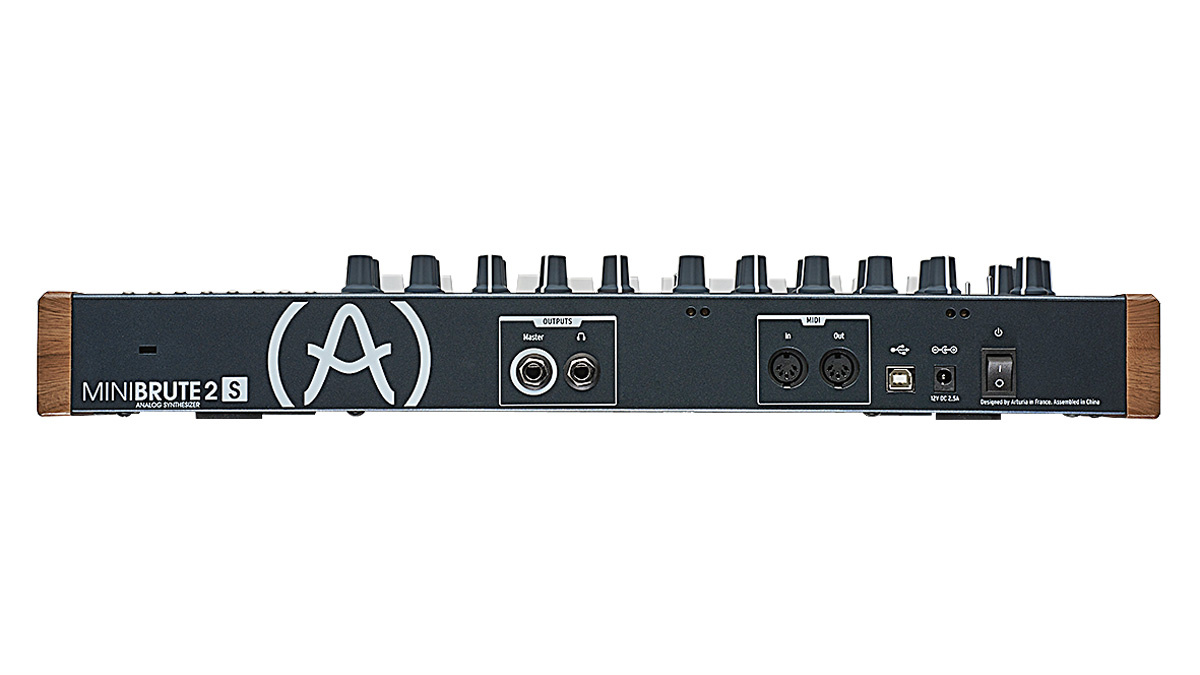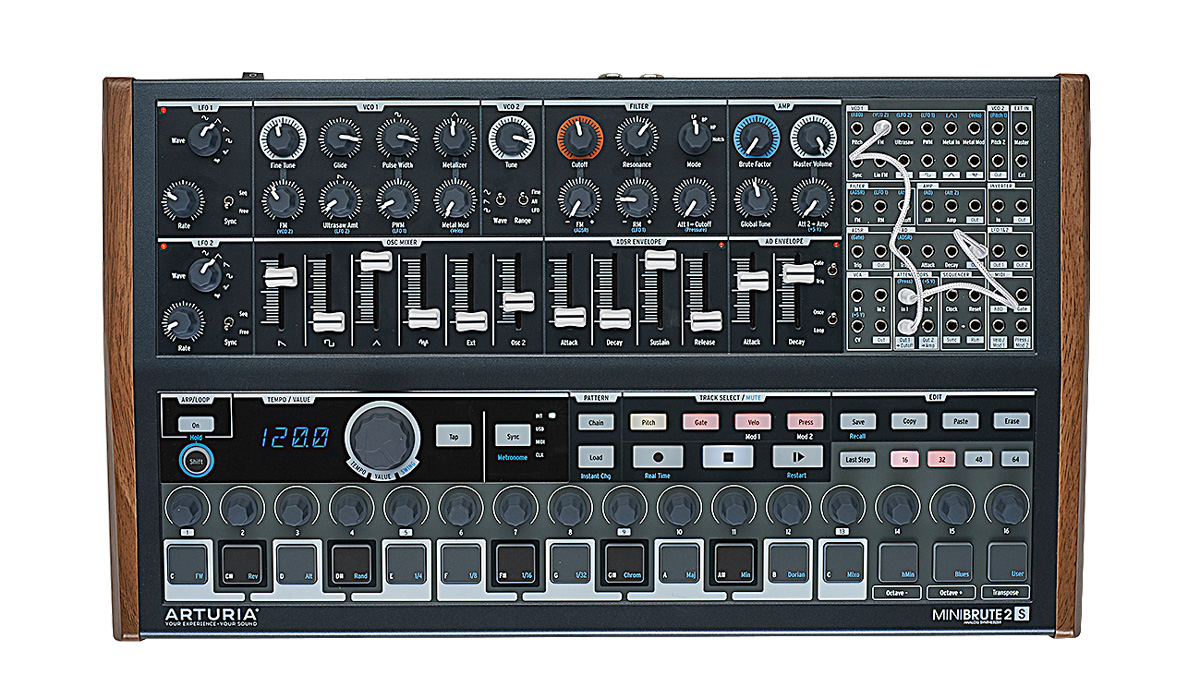MusicRadar Verdict
An expanded synth engine, semi-modular architecture and flexible control options make this a seriously competitive monosynth.
Pros
- +
Patchbay makes version 2 considerably more flexible than the original.
- +
The 2S sequencer is very impressive.
- +
Can interface with a whole host of external gear.
Cons
- -
Single -12dB VCF lacks flexibility.
MusicRadar's got your back
When Arturia’s original MiniBrute arrived in 2012, it was an unexpected first step into the realm of analogue synthesis for the French brand, which had previously dealt exclusively with analogue emulating software and digital controller hardware.
On a wider level too, the MiniBrute was a welcome anomaly - a monosynth pitched at the affordable end of the market yet touting an all analogue design and CV control inputs.
Six years later, neither of those things seem so noteworthy. Arturia’s analogue Brute line has now swelled to encompass three synths - including the behemoth MatrixBrute - and a drum machine, while the Beat- and KeyStep devices are go-to controllers for many hardware synthesists.
The affordable analogue market has grown remarkably rapidly too - a boom arguably kickstarted, at least in part, by the release of the MiniBrute. Given this, it’s not surprising that Arturia has significantly stepped things up for the follow up. Where the original was a fairly straightforward monosynth with a few unique touches and some CV control, the MiniBrute 2 is now semi-modular, boasting a beefed- up synth engine and a comprehensive mini-jack patchbay.
The MiniBrute now comes in two varieties too: the standard keyboard version, now equipped with a Keystep-style sequencer, and the 2S, which swaps the keys for a pad-based step sequencer similar to the BeatStep. Today, we’re looking at the MiniBrute 2S.
Souped-up
Leaving the patchbay and sequencers to one side for a moment, the core synth engine is very similar to that of version 1, albeit with a few noteworthy adjustments. As before, the primary oscillator can generate saw, triangle and square waves simultaneously, the outputs of which are blended via the oscillator mixer, where they’re joined by a white noise source and external audio input. Each wave type also has a modifier control, for more detailed and unusual wave-shaping.
The saw is accompanied by an Ultrasaw mode, which mixes in two phase-shifted copies of the saw waveform. The triangle wave features a Metalizer function, which ‘folds’ the triangle waveshape for a more metallic quality. Finally, the square wave features a pulse width control.
The difference here is that these modifiers can now each be modulated with considerably more flexibility either via pre-routed connections to the LFOs/modulators or via whatever you decide to feed in through the patchbay. The Osc 1 section also gains a glide rotary, for adding up to three seconds of portamento, plus an FM rotary for modulating Osc 1’s pitch, which is routed by default to the second oscillator.

Version one featured a square/sine sub oscillator, but here that has been upgraded to an independently tuneable oscillator with saw, square and triangle shapes. It also has a tuning range switch, with a fine tune mode for more precise melodic uses, an LFO mode, which reduces the oscillator speed for use as a non-audible modulation source, and a broad ‘all’ range mode. This oscillator also now gets its own fader in the oscillator mixer.
Filter-wise, the MiniBrute 2 keeps the Steiner-Parker-style filter of its predecessor, which offers -12dB low- and high-pass modes, plus -6dB band-pass and notch filtering. There’s a resonance control, which can be pushed up into aggressive grittiness and self-oscillation. Again, this section is enhanced with increased modulation options, with pre-routed and fully patchable control over the cutoff frequency and resonance level. For extra grittiness, the Brute Factor control returns from the original MiniBrute.
This overdrives the signal chain using a controlled feedback loop. It’s great for adding extra weight and inharmonic grittiness, although it can be a little unpredictable at times. On the modulation front, the MiniBrute 2 features a pair of multi-shape LFOs (in addition to Osc 2, which can act as a third). The two ADSR envelopes of the original have been swapped for a single ADSR generator - routed to the filter, but patchable - and an AD envelope, which controls the amp by default but is also fully patchable.
The AD envelope comes equipped with a variety of trigger modes, including a looping function, and patchable control over each stage, which makes it an interesting tool for sound design. Each env features a trigger input too.
Taking control
The 2S can be played and sequenced, and naturally there’s considerably more depth to the 2S’s sequencing capabilities in comparison to the recently-reviewed 2.
It packs multi-pattern arpeggiator and a 64-step sequencer, capable of saving and recalling patterns. The 2S also allows for patterns to be chained to create full songs, and features copy and paste functionality. Arturia’s MIDI Control Center software allows for storage of an unlimited number of patterns on a host computer too.
It also offers control over things like tempo, swing and sequencer gate length, along with tap tempo and a variety of sync options. It can be manually played too, with velocity and aftertouch for controlling various synth parameters. The 2S features a chromatic grid laid out across its pressure-sensitive pads (here aftertouch is labelled Pressure, but it functions exactly the same).
The highlight, however, is the flexibility of the sequencer’s four channels. The first two of these are fixed to Pitch and Gate, while the second two can act as multiple type of modulation source. By default they offer Velocity and Pressure, but both can also be set to output stepped voltage messages, trigger an AD envelope on each step, trigger various type of LFO or act as an additional gate source.
These second and third channels can be ‘unshackled’ from the primary sequencer too, allowing them to run in a different timing division or direction. The Pitch channel can make use of a scale mode too. This allows patterns to be easily transposed into other keys.
On the whole, the MiniBrute 2S is a real success. It takes everything we liked about the original - the analogue grit, interesting oscillator shaping, Brute factor - and expands on it considerably. The addition of the patchbay really does massively expand the flexibility and potential.
Where the original was a great tool for gritty leads and basses, this follow-up is equally well-equipped for evolving drones, inharmonic FM sounds and out-there SFX.
The MiniBrute 2’s closest competitor is probably Moog’s Mother-32 and much like that synth, which is housed in a Eurorack friendly chassis, Arturia clearly want the MiniBrute to act as a base for your modular system – it has even launched the RackBrute synth-top case to accommodate this.
On this front the MiniBrute probably has the edge over the Moog, thanks to the excellent keyboard/sequencers onboard, along with the flexible MIDI, USB and patchbay connections.
There are a couple of slight design quirks and minor omissions. On the layout front, Arturia has place Osc 2’s pitch rotary right next to the - identically sized - filter cutoff control. Personally we find it a little too easy to grab the wrong rotary.
In terms of capabilities too, while the supplied SP-style filter can be characterful and gritty, its maximum -12dB slope means it isn’t the most flexible of VCF designs.
The MatrixBrute pairs its Steiner-Parker filter with an additional ladder-design VCF. Clearly it’s a little unfair to compare the MiniBrute to its £1600+ sibling, but having used that synth, it’s hard not to feel that the addition of that second filter here would have pushed the MiniBrute 2 to the next level.
Failing that, a -24dB mode for the existing filter would be nice. This is kind of nitpicking though, and not really a major problem.
The MiniBrute 2S is an impressive analogue synth and a real step up from its predecessor. The patchbay adds flexibility and character that make this a very serious competitor in the now crowded analogue monosynth market.
I'm the Managing Editor of Music Technology at MusicRadar and former Editor-in-Chief of Future Music, Computer Music and Electronic Musician. I've been messing around with music tech in various forms for over two decades. I've also spent the last 10 years forgetting how to play guitar. Find me in the chillout room at raves complaining that it's past my bedtime.
The Curse of Coachella: Bad sound, bad gigs and even worse audiences… Is Coachella now the worst festival in the world?
They’re [heavily rumoured to be] back… Could Daft Punk be reforming for a residency inside Fortnite?
“Chinese Democracy was a boring record. But calling it Guns N' Roses was not honest. It was totally a solo record”: GN’R’s ex manager takes aim at Axl Rose










